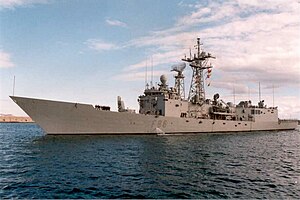 Canarias
| |
| History | |
|---|---|
| Name | Canarias |
| Namesake | Canarias |
| Builder | Bazan |
| Laid down | 15 April 1992 |
| Launched | 21 June 1993 |
| Commissioned | 14 December 1994 |
| Homeport | Rota |
| Identification |
|
| Status | in active service |
| General characteristics | |
| Class and type | Santa María-class frigate |
| Displacement | 3,160 t (3,110 long tons) standard |
| Length | 138.8 m (455 ft 5 in) |
| Beam | 14.3 m (46 ft 11 in) |
| Draught | 6.6 m (21 ft 8 in) max |
| Propulsion |
|
| Speed | 29 knots (54 km/h; 33 mph) |
| Complement | 223 |
| Sensors and processing systems |
|
| Electronic warfare & decoys | Nettunel (F-85 & F-86: Mk-3000) intercept, SLQ-25 Nixie, Mk36 SROC decoy launchers |
| Armament |
|
| Aircraft carried | 2 × Sikorsky SH-60B Seahawk LAMPS III helicopters |
Canarias (F86), is the last of the six Spanish-built Santa María-class frigates of the Spanish Navy, which are based on the American Oliver Hazard Perry-class design. The Santa María class offer both anti-air and anti-submarine defence for the Spanish Navy. The frigate was laid down by Bazan on 15 April 1992 and launched on 21 June 1993. Upon entering service on 14 December 1994, Canarias was homeported at Rota and assigned to the 41st Escort Squadron. Canarias has been assigned to Operation Atalanta of the Somali coast, combatting piracy and Operation Sophia in the Mediterranean Sea, intercepting illegal trafficking of migrants.